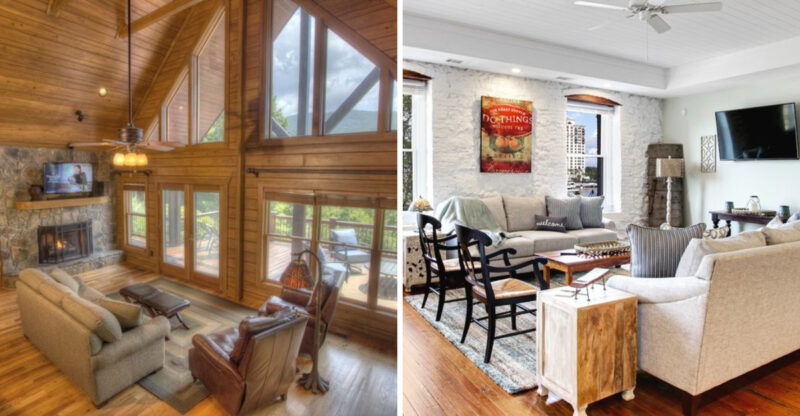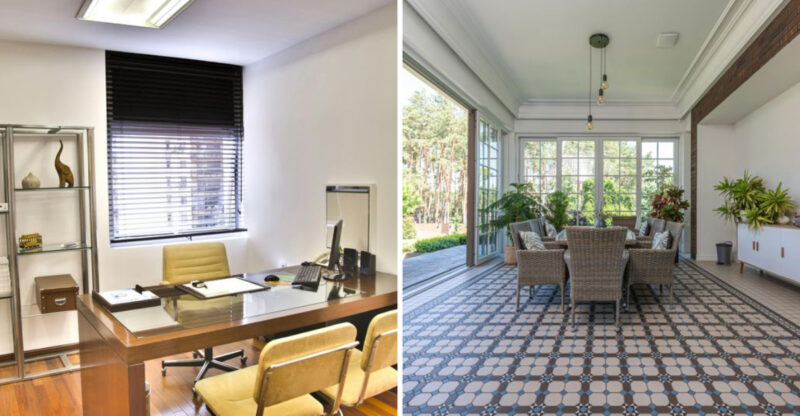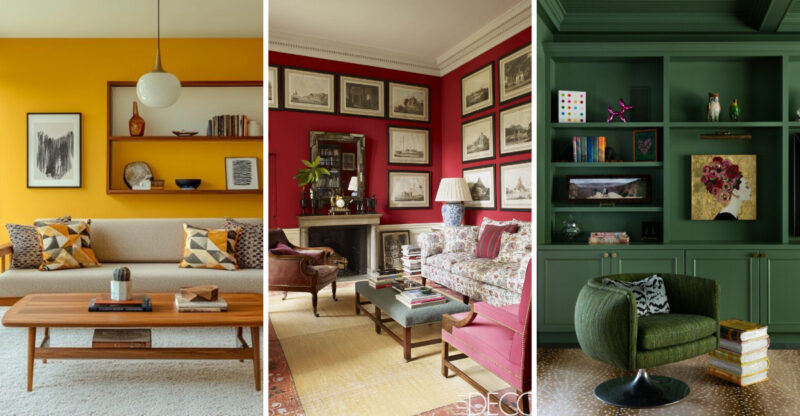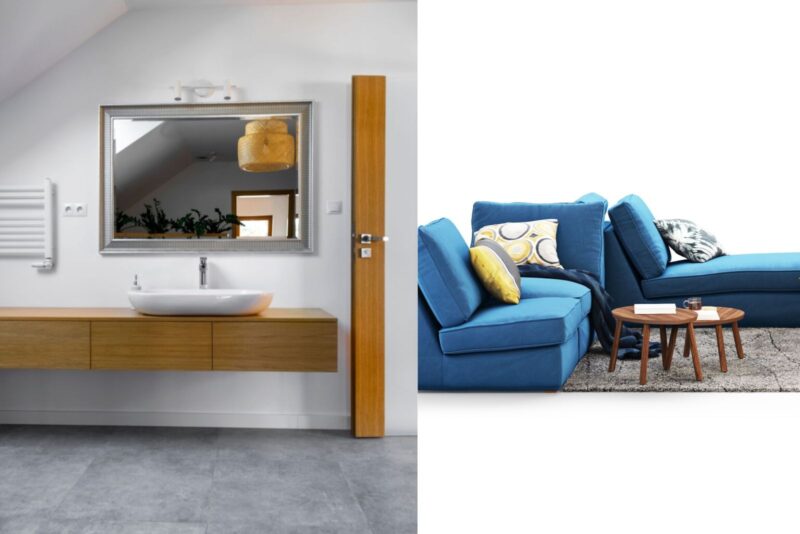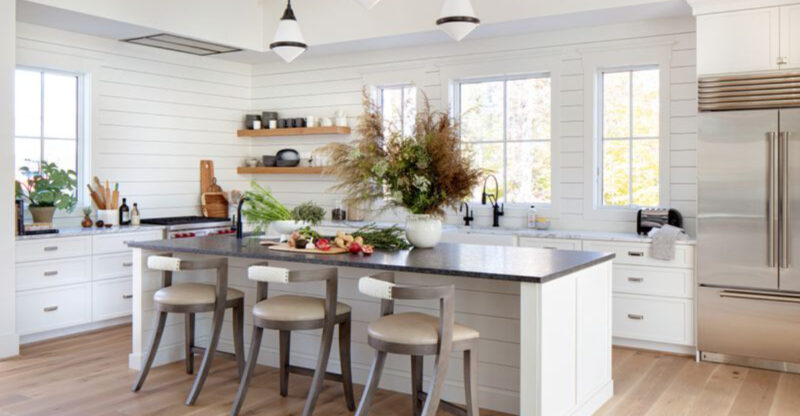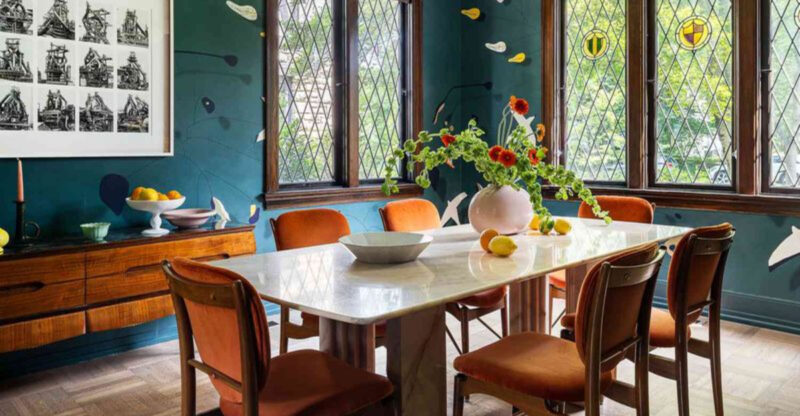What Makes These 14 Decor Trends From Stowe So Enduring
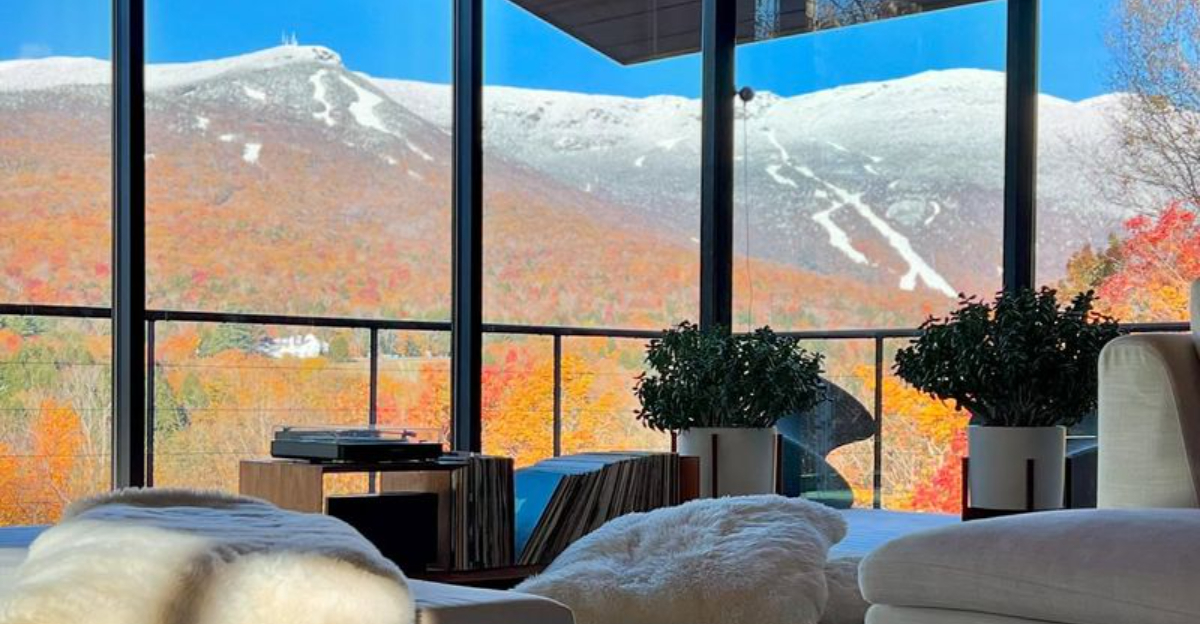
Nestled in Vermont’s breathtaking mountains, Stowe has cultivated a distinctive home design style that stands the test of time.
These decor elements blend functionality with the region’s natural beauty, creating spaces that feel both luxurious and authentically Vermont.
From materials sourced locally to designs that reflect the area’s rich heritage, these enduring trends showcase why Stowe’s aesthetic continues to captivate homeowners and designers alike.
1. Natural wood finishes
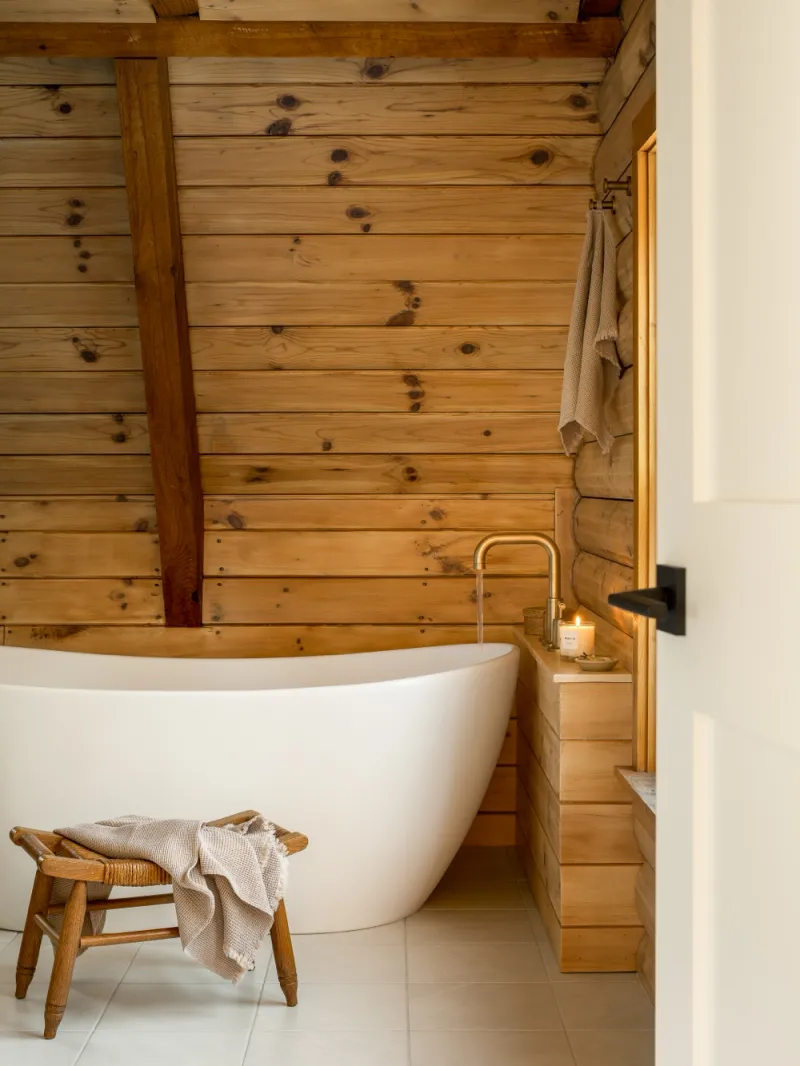
Vermont’s abundant forests inspire Stowe’s signature wood finishes that showcase grain patterns rather than hiding them. Local maple, birch, and pine transformed into flooring, paneling, and furniture create spaces that feel grounded and authentic.
Homeowners typically prefer clear or light stains that highlight wood’s natural character instead of masking it with heavy paint. This approach connects indoor spaces with the surrounding forest landscape.
Did you know? Many Stowe homes feature wood harvested within 100 miles, supporting local sustainable forestry practices while reducing transportation impacts. This connection to local resources gives these finishes a story and significance beyond mere decoration.
2. Cozy stone fireplaces
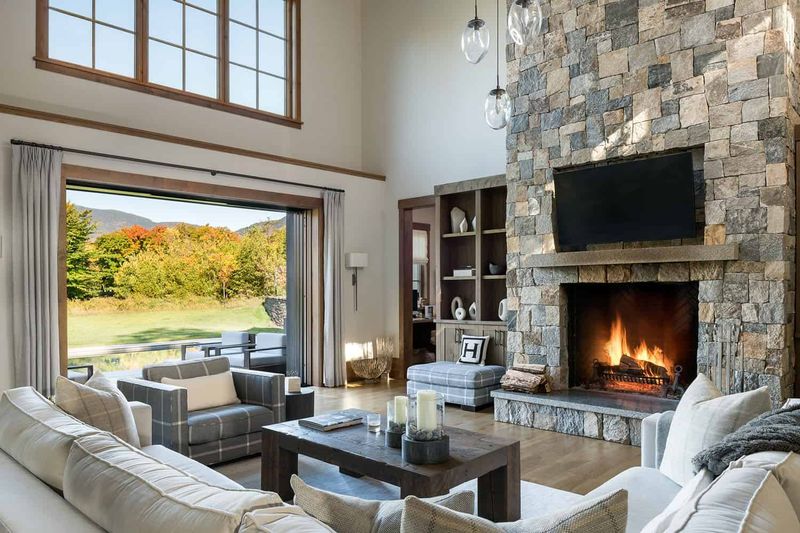
Nothing captures Stowe’s mountain charm quite like a stone fireplace that anchors living spaces with both warmth and visual weight. These aren’t just heat sources but gathering points that draw family and friends together during Vermont’s famous winters.
Local fieldstone and river rock create distinctive patterns impossible to replicate elsewhere. Each fireplace tells a unique story through its carefully selected stones and craftsmanship.
Hearths often extend generously into the room, creating practical seating areas that invite relaxation. The timeless appeal comes from their perfect balance of rustic character and refined execution – substantial enough to feel authentic yet meticulously crafted to complement even sophisticated interiors.
3. Flannel textiles and accents
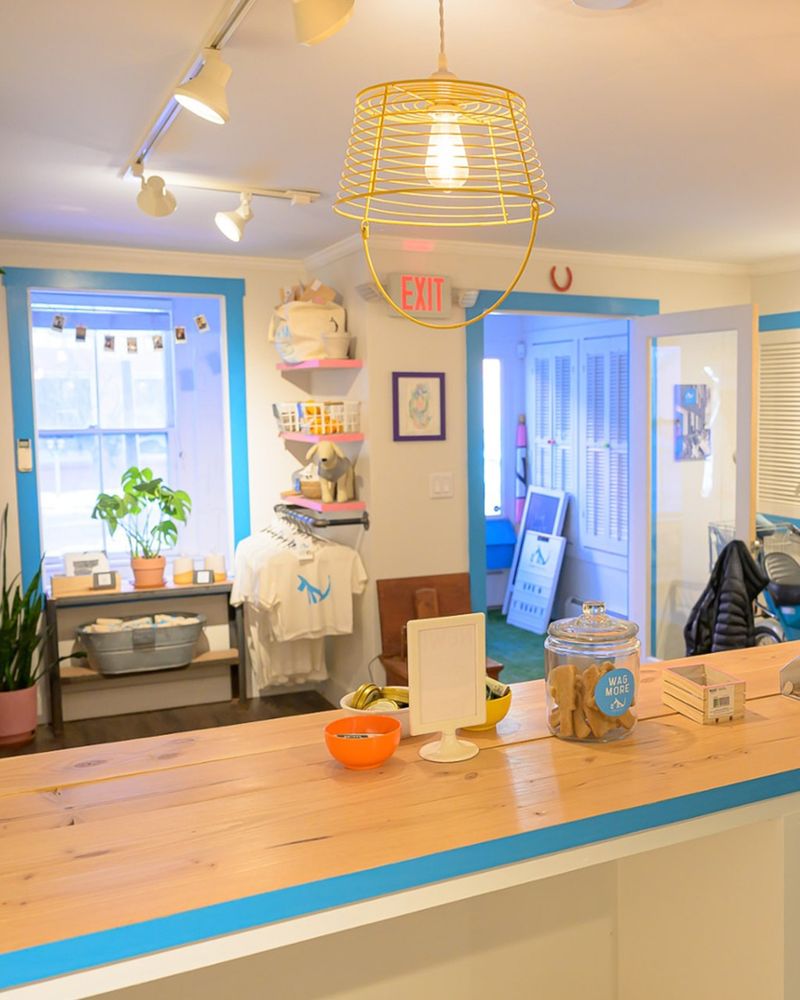
Flannel’s practical warmth meets visual comfort in Stowe homes where these soft textiles appear as throw pillows, blankets, and even upholstery. The material’s connection to Vermont’s outdoor heritage makes it feel particularly appropriate in mountain settings.
Modern interpretations move beyond traditional red-and-black buffalo check to include sophisticated plaids in forest greens, deep blues, and warm neutrals. These updated patterns maintain flannel’s cozy essence while fitting seamlessly into contemporary spaces.
I’ve noticed flannel accents work particularly well when layered with other textures like leather, wool, and linen. This thoughtful mixing prevents the look from becoming too themed or predictable while still honoring the material’s deep roots in New England’s design vocabulary.
4. Exposed timber beams
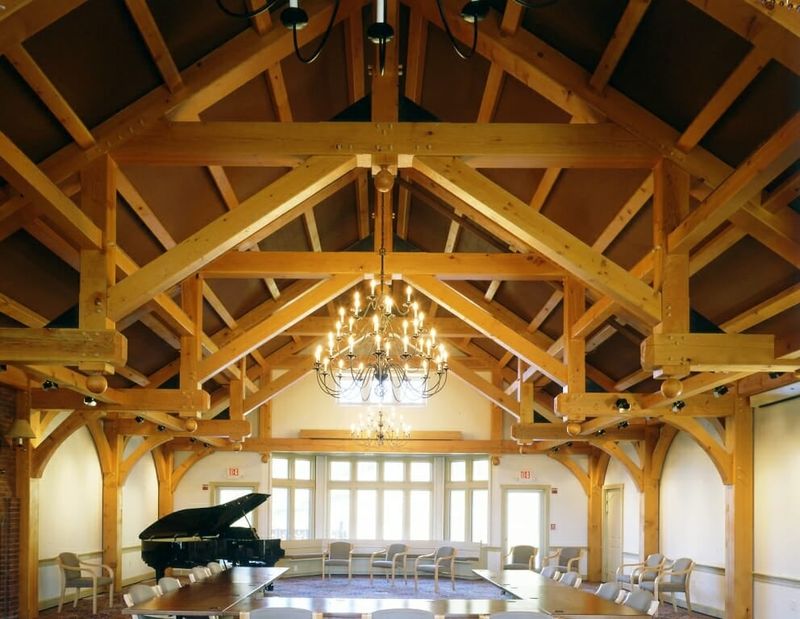
Hefty wooden beams running across ceilings bring architectural interest and mountain authenticity to Stowe interiors. Whether salvaged from historic barns or newly crafted from local timber, these structural elements create immediate character and visual anchoring.
Homeowners particularly value hand-hewn beams showing adze marks and other evidence of traditional craftsmanship. This celebration of human handiwork connects spaces to Vermont’s agricultural and forestry heritage.
When paired with white walls or plaster ceilings, these dark wooden elements create dramatic contrast that defines spaces without overwhelming them. The most successful applications balance the rustic quality of exposed beams with refined furnishings, preventing spaces from feeling too cabin-like while still honoring mountain building traditions.
5. Rustic wrought-iron hardware
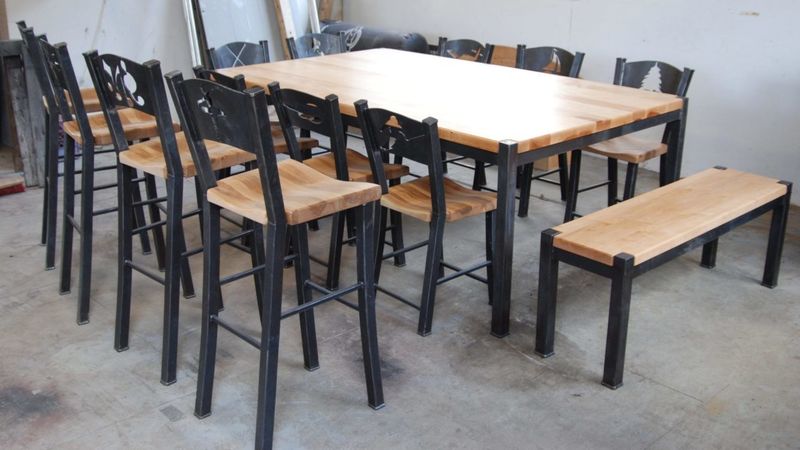
Hand-forged iron details add authentic character to Stowe homes through cabinet pulls, door hinges, stair railings, and light fixtures. These blackened metal elements provide visual contrast against wood and stone while connecting to Vermont’s long tradition of metalworking.
Local artisans create distinctive pieces that can’t be mass-produced, often incorporating regional motifs like maple leaves, pine boughs, or mountain silhouettes. These small touches tell a story of place and craftsmanship.
If you’re renovating, consider investing in quality iron hardware as focal points. Even in otherwise contemporary spaces, these elements add depth and historical resonance. The patina that develops over years of handling only enhances their appeal, making them truly better with age – a quality increasingly rare in our disposable design culture.
6. Warm, earthy color palettes
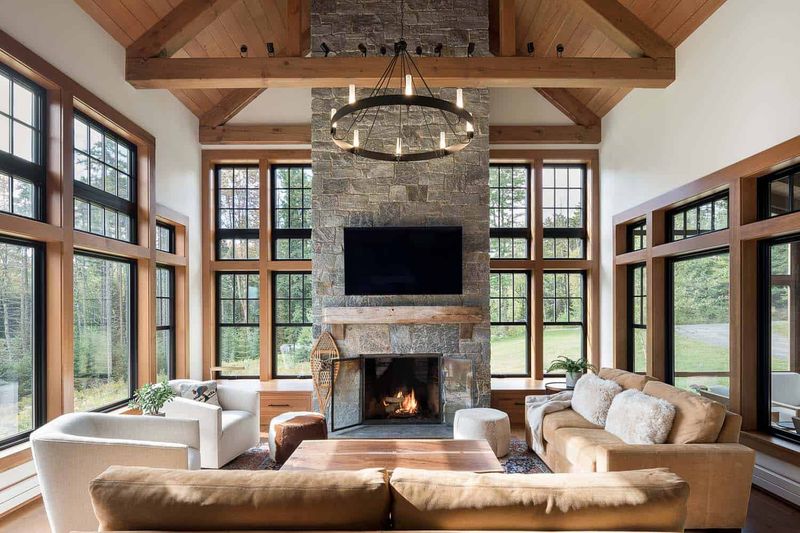
Vermont’s spectacular autumn landscapes inspire the enduring color schemes found throughout Stowe homes. Rich ambers, burnt oranges, forest greens, and deep burgundies create spaces that feel harmonious with the natural surroundings visible through windows.
These earthy tones appear as accent walls, textiles, and decorative elements against neutral backgrounds of cream, beige, or gray. The approach creates warmth without heaviness – particularly important during long Vermont winters when interiors need to feel cozy yet uplifting.
Are you considering this palette? Start with a single statement piece in a rich earthy tone rather than overwhelming a space. A burnt orange armchair or forest green kitchen island can anchor a room while allowing the eye places to rest. This balanced approach explains why these colors remain relevant decade after decade.
7. Handcrafted furniture pieces
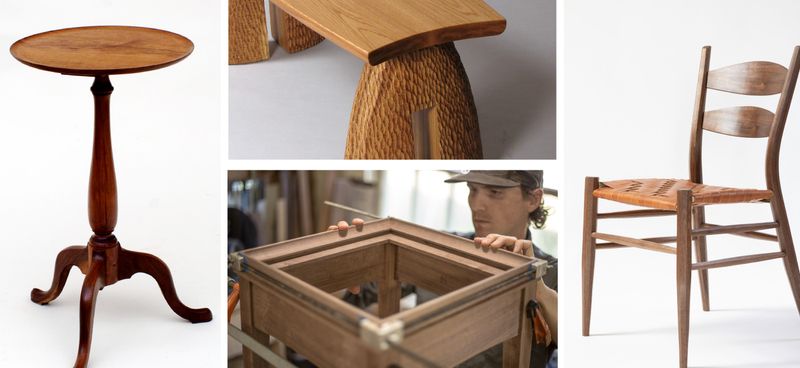
Vermont’s renowned furniture-making tradition shines in Stowe homes through custom pieces that showcase exceptional craftsmanship. Dining tables with butterfly joints, chairs with hand-carved details, and beds with mortise-and-tenon construction demonstrate an appreciation for quality that transcends trends.
Local woodworkers create these signature pieces using sustainable practices and regional materials. Many homeowners commission specific items that address their unique needs while supporting the area’s creative economy.
The investment in handcrafted furniture pays dividends beyond aesthetics. These pieces develop character with age and use, often becoming family heirlooms passed through generations. When I visit homes featuring decades-old Vermont-made furniture, I’m always struck by how these pieces remain both beautiful and relevant – a testament to design that prioritizes timelessness over trendiness.
8. Vintage ski lodge decor
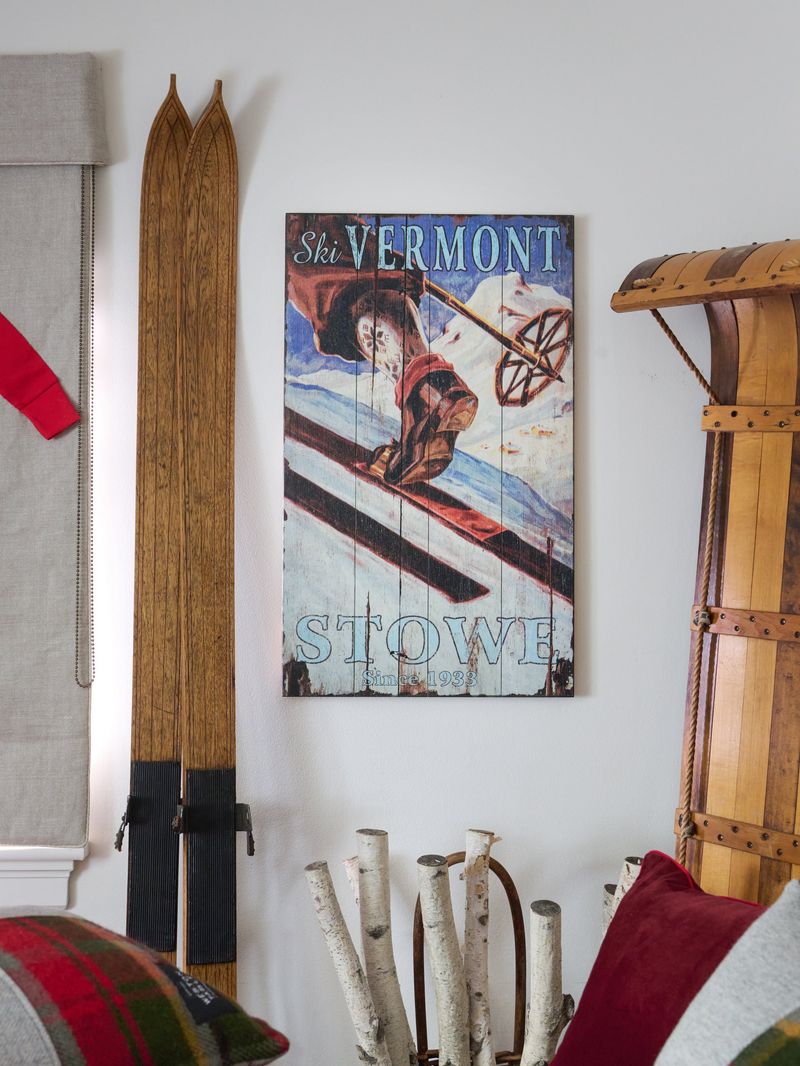
Stowe’s identity as a premier ski destination finds expression through thoughtfully incorporated vintage ski equipment and memorabilia. Antique wooden skis mounted above doorways, framed historic trail maps, and black-and-white photographs of early ski pioneers add layers of authentic local history.
The most successful applications avoid theme-park territory by using these elements sparingly as artistic focal points. A single pair of 1940s skis displayed as wall art carries more impact than multiple pieces crowded together.
Vintage wool ski sweaters repurposed as pillow covers offer another subtle nod to the region’s winter sports heritage. This approach to decorating connects homes to Stowe’s remarkable skiing legacy while creating conversation pieces that spark stories and memories. The emotional resonance explains why these decorative elements continue appearing in both historic and newly-built Stowe properties.
9. Layered area rugs
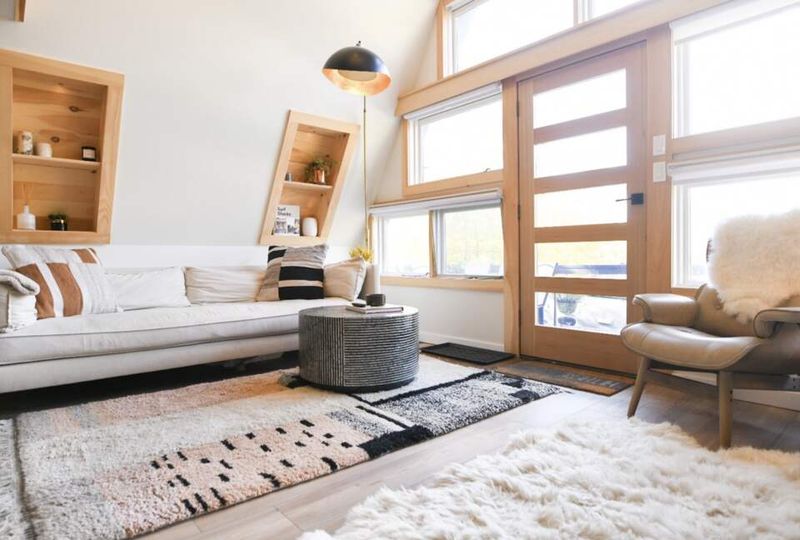
Vermont’s cold floors demand the practical warmth of layered rugs, creating an approach to floor coverings that’s both functional and visually rich. Stowe homes often feature larger neutral base rugs topped with smaller vintage or hand-woven pieces in complementary colors and patterns.
This layering technique allows homeowners to introduce color and texture while protecting investment pieces. A hardwearing jute or sisal base rug might be topped with a more delicate antique Oriental carpet, preserving the finer piece while adding depth to the room’s design.
Beyond practicality, layered rugs create zones within larger spaces particularly valuable in the open floor plans common in mountain homes. The technique visually separates conversation areas from dining spaces without requiring walls, maintaining openness while defining purpose. This blend of beauty and functionality exemplifies Stowe’s enduring design philosophy.
10. Classic shaker-style cabinetry
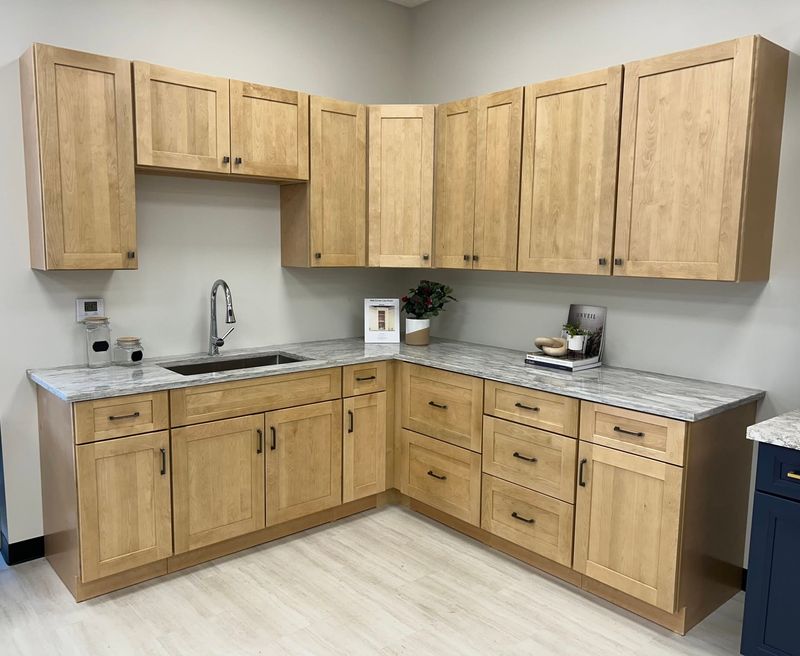
Shaker cabinetry’s clean lines and emphasis on craftsmanship make it a perfect fit for Stowe kitchens and bathrooms. The style’s simplicity works equally well in historic renovations and contemporary new builds, explaining its staying power across decades.
Though often painted white or cream, Stowe’s interpretation frequently features natural wood finishes that showcase local maple, cherry, or birch. The straightforward design puts emphasis on quality materials rather than elaborate detailing.
Hardware choices range from traditional black iron pulls to more contemporary brushed nickel, allowing the same cabinet style to read as either historical or modern depending on accessories. This adaptability makes Shaker cabinetry particularly valuable in Vermont, where respecting architectural heritage matters but homeowners still want functional, updated spaces. The style’s inherent versatility explains why it remains Stowe’s dominant cabinet choice.
11. Nature-inspired artwork
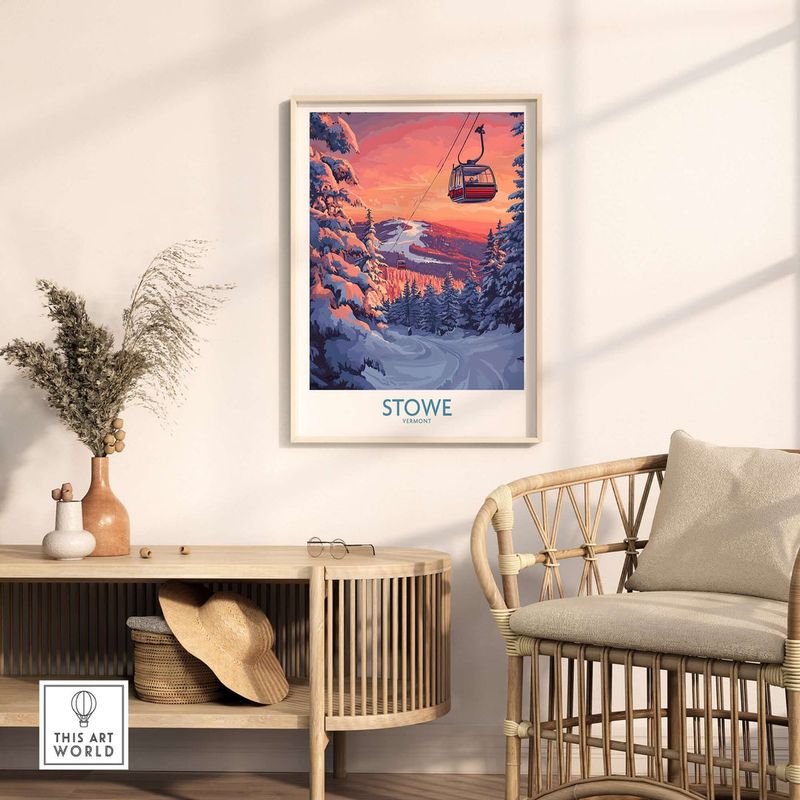
Vermont’s spectacular landscapes provide endless inspiration for the artwork adorning Stowe homes. Local artists capture the region’s distinctive mountains, forests, and changing seasons in paintings, photographs, and mixed media pieces that bring natural beauty indoors.
Many homeowners collect works depicting specific local landmarks like Mount Mansfield or Smugglers Notch. These pieces create meaningful connections to favorite places while supporting Vermont’s vibrant arts community.
Though landscapes dominate, botanical illustrations, wildlife art, and abstract pieces inspired by natural forms also feature prominently. The most interesting collections mix mediums and perspectives perhaps pairing a traditional oil painting of autumn foliage with contemporary photography of winter ice formations. This approach creates visual conversation between pieces while maintaining the nature-based theme that grounds Stowe interiors in their magnificent setting.
12. Wool and fur throws
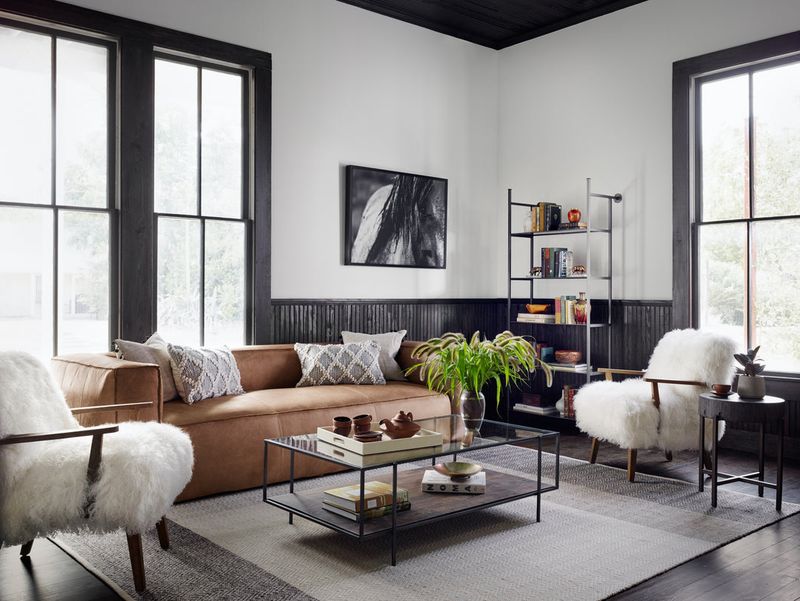
Vermont winters demand serious warmth, making wool and fur throws essential in Stowe homes. These tactile layers transform couches, chairs, and beds into inviting retreats during the region’s famously cold months.
Hudson Bay blankets, Scottish tartans, and locally-made wool throws in neutral tones create a collected, layered look that feels both luxurious and appropriate. Sheepskins draped over reading chairs add additional texture and practical warmth.
Many homeowners now choose ethically-sourced or faux fur options that maintain the visual richness without environmental concerns. The best throws serve double duty as both functional warmth-givers and decorative elements that add visual weight to rooms. Their practical necessity explains their enduring presence, while changing materials and patterns keep the look fresh. Few decorative elements so perfectly balance form and function in a mountain setting.
13. Traditional Vermont pottery
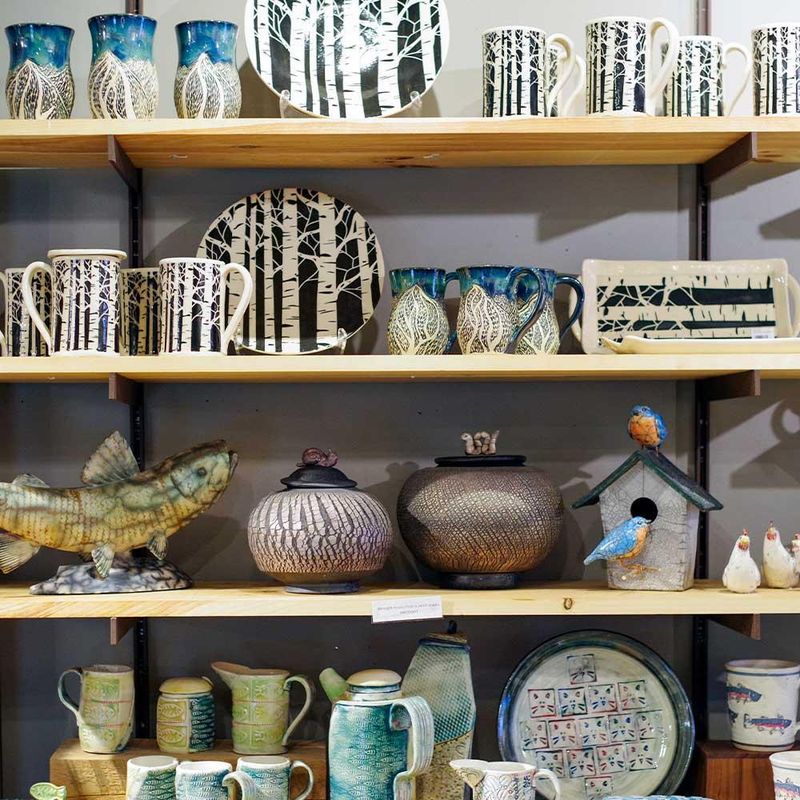
Handcrafted stoneware from Vermont’s renowned pottery studios adds authentic character to Stowe homes through everyday items like serving bowls, mugs, and vases. These pieces blend practicality with artistic merit – beautiful enough to display yet durable enough for daily use.
Distinctive glazes in blues, greens, and earthy browns reference the region’s landscape while adding subtle color to neutral interiors. Many homeowners collect specific patterns or makers, building meaningful collections over time.
Beyond tableware, larger statement pieces like floor vases and decorative platters serve as artistic focal points. What makes Vermont pottery particularly special is the connection to place – many studios welcome visitors to watch the making process, creating personal stories behind each piece. This combination of beauty, functionality, and local significance explains why these ceramic elements remain central to Stowe’s design aesthetic decade after decade.
14. Large windows framing mountain views
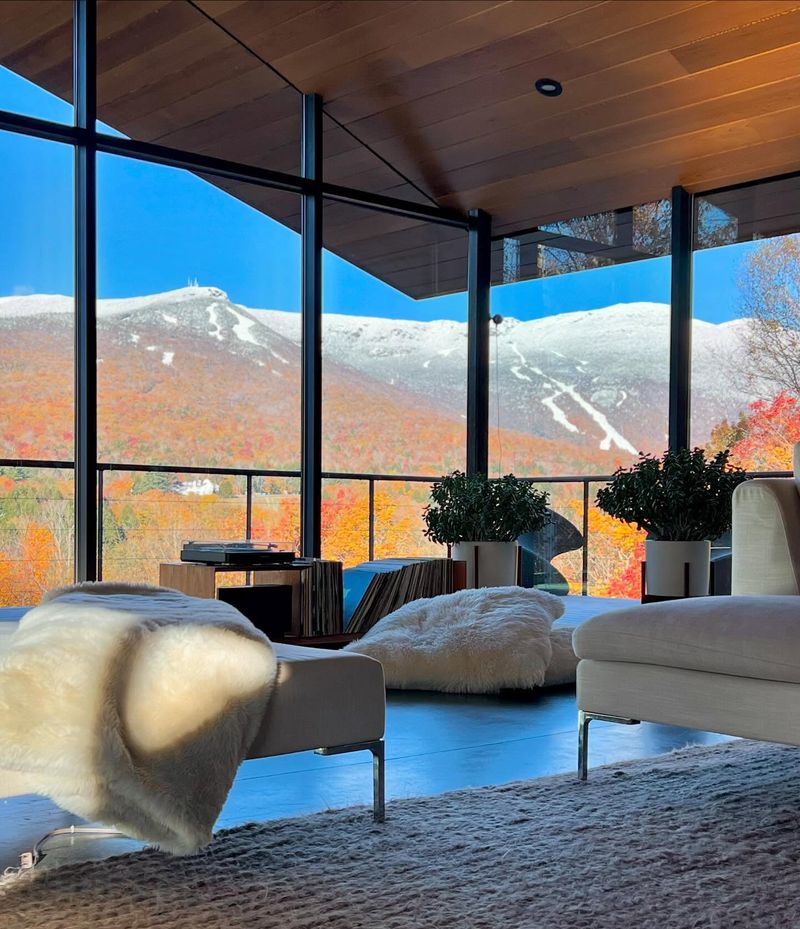
Stowe’s spectacular landscape becomes living artwork through strategically placed windows that frame mountain vistas. Homeowners invest in expansive glass that captures views of Mount Mansfield, surrounding forests, and dramatic weather patterns throughout changing seasons.
Window treatments typically remain minimal to maximize visual connection with the outdoors. When privacy or light control is needed, simple linen panels or wooden blinds provide solutions without competing with the views.
Architects carefully position these windows to capture specific vantage points – perhaps a distant mountain peak or a nearby stand of birch trees. Furniture arrangements acknowledge these views as focal points, often orienting seating to take advantage of the natural spectacle. This integration of interior and exterior spaces creates homes that feel expansive beyond their actual dimensions while celebrating Vermont’s extraordinary natural beauty.

